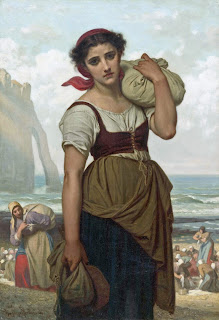William Bouguereau: Washerwomen of Fouesnant
Paintings from 19th century France, from Neoclassic to Academic to Barbizon. Impressionism is not covered here.
Monday, November 30, 2015
Sunday, November 29, 2015
Sunday, November 22, 2015
Saturday, November 21, 2015
Friday, November 20, 2015
Thursday, November 19, 2015
Wednesday, November 18, 2015
Tuesday, November 17, 2015
Portrait of a Young Woman (1869)
Pierre Auguste Cot: Portrait of a Young Woman
Although he was influenced by multiple academic sources, Cot based much of his artistic output on the subjects and style of his teacher Bouguereau. The Academic style was in its finest form when it came to portraits. In many of Cot’s portraits, there is an undercurrent of eroticism flowing just beneath the surface.
Monday, November 16, 2015
Inauguration of the Suez Canal
Edouard Riou: Inauguration of the Suez Canal
This event took place in our current year of 1869; the date of the painting is unknown (to me, anyway).
Sunday, November 15, 2015
Saturday, November 14, 2015
Friday, November 13, 2015
The Supper at Beaucaire (1869)
Jean-Jules-Antoine Lecomte du Nouÿ: The Supper at Beaucaire
This scene depicts an event that occurred at the beginning of Bonaparte's career, when he was still a young captain. He was responsible for conveying powder intended for soldiers of the Army of Italy, in the middle of the federalist insurrection of Midi. On 28 July 1793, he arrived in Beaucaire at the house of Mr. Renaudet, pharmacist, and at night he dined at an inn with four merchants who had come to a fair. It was after this meal he wrote a dialogue text entitled The Supper at Beaucaire, in which he made a Republican profession of faith, trying to convince his interlocutors the need of the Revolution. [L'Histoire par l'Image]
Thursday, November 12, 2015
Bashi-Bazouk (ca. 1869)
Jean-Léon Gérôme: Bashi-Bazouk
This arresting picture was made after Gérôme returned to Paris from a twelve-week journey to the Near East in early 1868. He was at the height of his career when he dressed a model in his studio with textiles he had acquired during the expedition. The artist’s Turkish title for this picture—which translates as "headless"—evokes the unpaid irregular soldiers who fought ferociously for plunder under Ottoman leadership, although it is difficult to imagine this man charging into battle wearing such an exquisite silk tunic. Gérôme’s virtuosic treatment of textures provides a sumptuous counterpoint to the figure’s dignified bearing. [Metropolitan Museum of Art]
Wednesday, November 11, 2015
Tuesday, November 10, 2015
Monday, November 9, 2015
Sunday, November 8, 2015
A Bay with Cliffs (ca. 1869)
Gustave Courbet: A Bay with Cliffs
In 1869, Gustave Courbet painted A Bay with Cliffs. Five years earlier, the photographer Louis- Alphonse Davanne photographed cliffs and a nearby bay in Étretat, the Manneporte. Though the differences between their respective representations of the awe-inspiring coastal landscape in Normandy were vast, the painter and the photographer found that this small stretch of France’s northern coast offered a rich set of possibilities for the production of a new form of picture making, which would transform the visual arts over the latter part of the nineteenth century. Courbet’s painting was part of an evolving project shared by many nineteenth-century French painters that sought to challenge the traditions of art making with a new visual vocabulary based on subjective experience.
In A Bay with Cliffs, the rules of perspective and symmetry are thrown out in favor of a landscape that cuts off the traditional horizon line with a bold, rocky cliff rendered with a thick layer of paint. Courbet eschewed traditional landscape painting in favor of conveying the material immediacy of his natural surroundings. Normandy, with its dramatic coastline and soaring cliffs, provided the painter with an ideal location to explore new possibilities of landscape painting. [Photography and Painting Along the Normandy Coast, 1850-1874. University of Michigan Museum of Art (pdf)]
Saturday, November 7, 2015
Friday, November 6, 2015
The Land of Thirst (1869)
Eugène Fromentin: The Land of Thirst
In this composition, made in the last years of the Second Empire, it is possible to compare an anecdotal representation of the desert to Guillaumet’s extreme simplicity. Like so many of his famous works, Fromentin’s composition is based on a story from one of his novels – in this case, a story at the end of Un Été dans le Sahara, originally published in 1857. These figures, abandoned in the desert, are literally expiring in our midst; the desert itself, as a powerful force of nature, is paramount in this representation. While the figures add an element of human interest, Fromentin has provided them with realistic (as opposed to fantastic) dress, perhaps in order to make more forceful the actual tragedy the viewer witnesses…The placement of the figures is meant to appear natural, but is in fact rather artfully composed. [John Zarobell, Empire of Landscape: Space and Ideology in French Colonial Algeria, Pennsylvania State University Press, 2010, p. 147]
Thursday, November 5, 2015
Jean-Baptiste Camille Corot (1869)
Jean-Baptiste Camille Corot: A Woman Reading in a Landscape
Jean-Baptiste Camille Corot: Nantes, the Cathedral
and the City Seen through the Trees
Wednesday, November 4, 2015
Tuesday, November 3, 2015
Monday, November 2, 2015
Diderot and His Scribe (1869)
Ernest Meissonier: Diderot and His Scribe
Denis Diderot (1713-1784) was a French philosopher, art critic, and writer. He was a prominent figure during the Enlightenment. Diderot's literary reputation during his lifetime rested primarily on his plays and his contributions to the Encyclopédie; many of his most important works, including Jacques the Fatalist, Rameau's Nephew, and D'Alembert's Dream, were published only after his death. [Wikipedia]
Sunday, November 1, 2015
Subscribe to:
Posts (Atom)

























